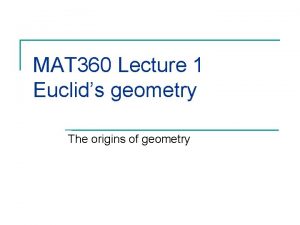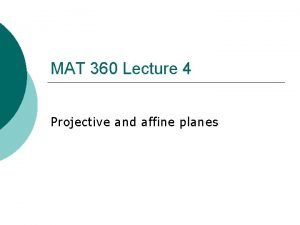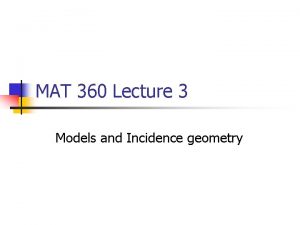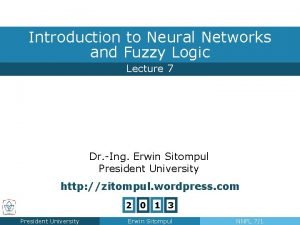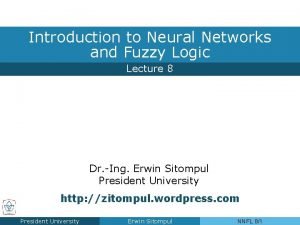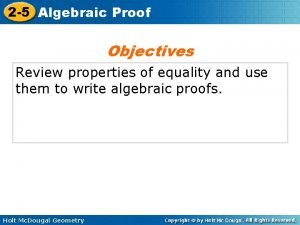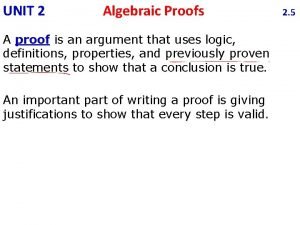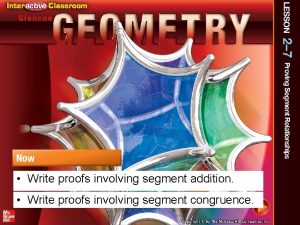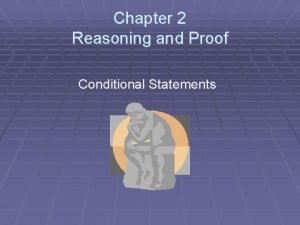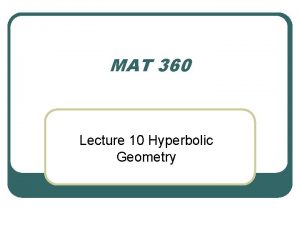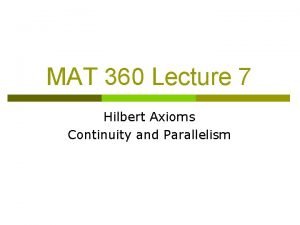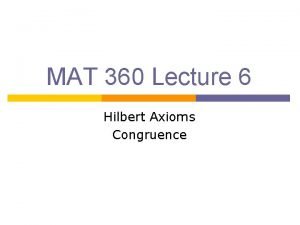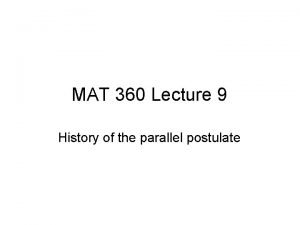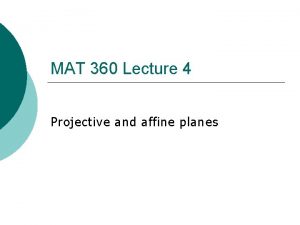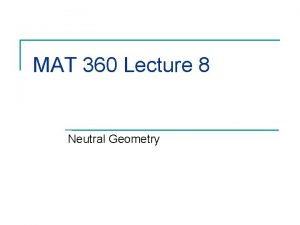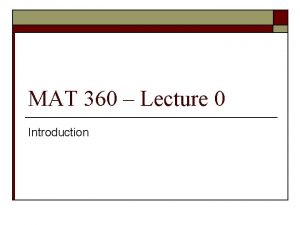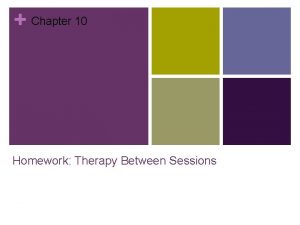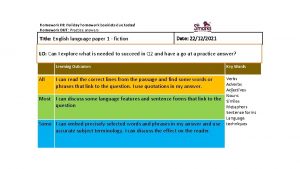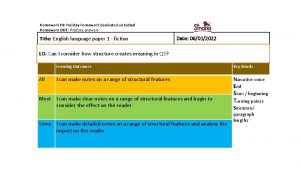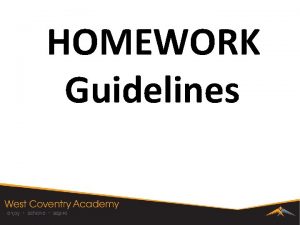MAT 360 Lecture 2 Logic Homework for Tuesday





















![The list of rules (continued): n Logic rule 9 1. 2. 3. 4. [(P=>Q)&(Q=>R)] The list of rules (continued): n Logic rule 9 1. 2. 3. 4. [(P=>Q)&(Q=>R)]](https://slidetodoc.com/presentation_image_h2/5ed0bf75208f1377813030f0a38d3bbd/image-22.jpg)






- Slides: 28

MAT 360 Lecture 2 Logic

Homework for Tuesday Sept 26 th n n Chapter 2: Exercises 1, 2, 3, 4, 5. Prove that √ 10 is not a rational number.

The axiomatic method n n A list of undefined terms. A list of statements (called axioms or postulates) A list of rules which tell when one statement follows logically from other. Definition of new words and symbols in term of the already defined or “accepted” ones.

The list of rules Logic rule 0 All the assumptions used in a proof must be previously stated.

The general form of a mathematical statement is n If (HYPOTHESIS) then (CONCLUSION) Theorems, Lemmas, Corollaries, Propositions are mathematical statements.

The list of rules (continued): Logic rule 1 The justifications allowed in proofs are the following n n n By hypothesis X, By axiom X, By theorem X By definition X, By step X, By (logic) rule X Where X refers to something already stated.

NOTATION: If S and R denote statements then • -S denotes the negation of S, or “S is false” • S => R denotes the statement “if S then R” • S&R denotes the statement “S and R” Note: S or R means that either S hold, or R holds, or S and R holds.

EXAMPLE: What is –S if S is 1. Two times three is six. 2. Two times three is ninety. 3. Euclid’s first postulate.

Definition n A contradiction is an statement of the form (S & -S)

The list of rules (continued): Logic rule 2: Reductio ad absurdum (RAA) or contradiction To prove the statement If HYPOTHESIS then CONCLUSION, one can prove the statement If (-CONCLUSION & HYPOTHESIS) then (CONTRADICTION)

Example: (using arithmetic) n Prove that √ 2 is not the quotient of two natural numbers. n Watch out! The legend tells that Hippasus of Metapontum proved this result on the sea, and as a consequence was thrown overboard.

The list of rules (continued): n n n Logic rule 3: The statement –(-S) means the same as S. Logic rule 4: The statement –(If H then C) means the same as (H & -C) Logic rule 5: The statement –(S & R) means the same as (-S or -R)

Exercise n Consider the statements S : Today is Monday q R : Today is Tuesday Write down the statements: q n n n S&R If S then R -S or R -(If S then R) -(S&R)

EXAMPLE n Consider the following statement, Every even number larger than 2 can be written as a sum of two primes. Which can be written as For every natural number x, if x is even and larger than 2 then there exist primes numbers y and z such that x=y+z

Quantifiers: Suppose that x is a variable n We abbreviate the expression “For all x” as n. We abbreviate the expression “There exists an x” as n Universal quantifier n. Existential quantifier

Exercise: Rewrite using quantifiers. n Every even number larger than 2 can be written as a sum of two primes.

The list of rules (continued): n Logic rule 6: The statement the same as the statement means

Exercise: Using quantifiers, write the negation of n Every even number larger than 2 can be written as a sum of two primes.

The list of rules (continued): n Logic rule 7: The statement the same as the statement means

The list of rules (continued): n Logic rule 8 (Modus ponens or the rule of detachment) If the statements P and P=>Q are steps of a proof, then Q is a justifiably step.

EXAMPLE n n Suppose that P is the statement : 60 is a multiple of 6. Find a statement Q with the property that P=>Q holds. What happens with Q? Can you prove Q?
![The list of rules continued n Logic rule 9 1 2 3 4 PQQR The list of rules (continued): n Logic rule 9 1. 2. 3. 4. [(P=>Q)&(Q=>R)]](https://slidetodoc.com/presentation_image_h2/5ed0bf75208f1377813030f0a38d3bbd/image-22.jpg)
The list of rules (continued): n Logic rule 9 1. 2. 3. 4. [(P=>Q)&(Q=>R)] => (P=>R) (P & Q) => P (P & Q) => Q (-Q => -P) <=> (P =>Q)

EXERCISE. Check whether the following syllogisms are correct n n n The walls are pink. It is not true that if the walls are pink then Romeo loves Juliet. HENCE, Romeo does not love Juliet.

The list of rules (continued): n Logic rule 10 (law of the excluded middle): For every statement P, the statement “P or –P” is a valid step in a proof.

EXERCISE. Check whether the following syllogisms are correct n n n No elves are in Lord of the Rings. Every creature in Lord of the Rings is tall. Hence, No elves are tall.

EXERCISE. Check whether the following syllogisms are correct 1. If this course is hard or interesting, then today we are in January. 2. This course is interesting. 3. If we are in January this course is not interesting. 4. HENCE, today is raining.

Logic rules (the end) n Logic rule 11 (proof by cases): Suppose the statement S 1 or S 2 or … or Sn is a valid step in a proof. Suppose that the proof of a statement C is carried out for each S 1, S 2 , … , Sn Then C can be concluded as a valid step of a proof.

EXERCISE: Prove that n The square of every integer number is positive.
 Mat för unga idrottare
Mat för unga idrottare Tuesday homework
Tuesday homework Mat 360
Mat 360 Mat 360
Mat 360 Mat 360
Mat 360 01:640:244 lecture notes - lecture 15: plat, idah, farad
01:640:244 lecture notes - lecture 15: plat, idah, farad Homework oh homework
Homework oh homework Homework oh homework i hate you you stink
Homework oh homework i hate you you stink Homework oh homework i hate you you stink
Homework oh homework i hate you you stink Literal and figurative language
Literal and figurative language Parts of a poem
Parts of a poem Homework oh homework jack prelutsky
Homework oh homework jack prelutsky Fuzzy logic lecture
Fuzzy logic lecture Fuzzy logic lecture
Fuzzy logic lecture Fuzzy logic lecture
Fuzzy logic lecture Direct algebraic proof
Direct algebraic proof Unit 2 logic and proof homework 6 algebraic proof
Unit 2 logic and proof homework 6 algebraic proof Proofs involving segment congruence
Proofs involving segment congruence Proving conditional statements
Proving conditional statements Majority circuit
Majority circuit Combinational logic vs sequential logic
Combinational logic vs sequential logic Combinational logic sequential logic 차이
Combinational logic sequential logic 차이 First order logic vs propositional logic
First order logic vs propositional logic Cryptarithmetic problem logic+logic=prolog
Cryptarithmetic problem logic+logic=prolog Logic chapter 3
Logic chapter 3 First order logic vs propositional logic
First order logic vs propositional logic Project management plan example
Project management plan example Third order logic
Third order logic Offentlig förvaltning
Offentlig förvaltning


